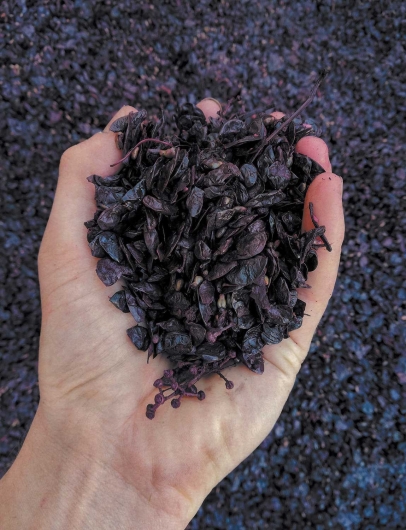Drink Your Wine & Eat it, Too
{On doctor’s orders}
Science tells us that electively feeding the right bacteria to the gut is key to preventing infection, inflammation and more. Enter a new line of chocolates from Healdsburg’s Vine to Bar that features an ingredient loaded with the antioxidants and prebiotic fibers beneficial to gut health. Better yet, that central ingredient is a byproduct of winemaking—and thus available in great abundance in our area. Winning!
If you believe that the future of what we consider to be “healthy eating” lies not in counting calories or fat grams or any other familiar metric, you will be heartened to hear that Vine to Bar has designed their chocolates not only to satisfy your taste buds, but to also improve your overall health. Their not-so-secret ingredient? Chardonnay marc. Marc (pronounce it as the French do, with a silent “c”), sometimes also referred to as pomace, is actually one step beyond pomace—the grape skins and seeds leftover from pressing wine. To obtain marc, pomace is cleaned and dried so it’s suitable for other uses. Every winemaking operation produces tons of pomace, so what do with it is an age-old question.
Peggy Furth and Barbara Banke Put Their Heads Together
Good friends for decades, Peggy Furth, founder of Chalk Hill Vineyards and Winery with her husband, Fred, and Barbara Banke, chairperson and proprietor of Jackson Family Wines, each already had a full slate of business responsibilities, philanthropic work and other endeavors. Making chocolate was never on their “to do” lists. That changed in 2009 when Banke, as part of a winery-wide effort to bring sustainability to the heart of the business, began a search for a productive use for her company’s pomace.
While traveling together in Greece, Furth and Banke happened upon a flow chart of potential uses for pomace deep within an enology research paper. That discovery launched the two on a pomace sustainability jag upon their return to the States. “We went to UC Davis to see what research projects they had in the Department of Enology—on the totality of the vineyard output,” Furth says. It was the beginning of a massive upcycling effort, to use the whole vine, including the pomace that had been formerly regarded as a waste product.
Soon after, the two friends co-founded Sonomaceuticals, an enterprise dedicated to the production of neutraceuticals, or food products promising health benefits, and two sub-brands, WholeVine and WellVine. Under WholeVine, the company initially launched a line of grapeseed oils and a flour made of ground grape seeds and grape skins that was baked into cookies, crackers and other products.
“That was good and there was a lot of interest, but it was hard to reach any scale of business,” Furth says. With the lessons learned from WholeVine, Sonomaceuticals more recently launched WellVine with the intent of carrying forward the research and process developments needed to bring these next-generation uses of pomace into the mainstream.
Getting to the Bottom of Pomace, aka Marc
Under the guidance of the company’s president, Scott Forsberg, WellVine launched an exploration of the specific characteristics of Jackson Family Wines’ pomace. After carefully cleaning and drying pomace to capture the aromatics before grinding it into a fluffy, flaky powder, they submitted samples to the U.S. Department of Agriculture (USDA). “Through our efforts with the USDA, we found out that not only was marc safe [to consume], but exceptionally healthy.” The Jackson Family Wines’ marc tested like a nutritional champ.
Antioxidants and Prebiotics Galore
Of note were very high levels of both phenolics and oligosaccharides. Phenolics are antioxidants that prevent cellular damage caused by free-radical oxidation reactions and promote anti-inflammatory conditions when consumed on a regular basis. In very simple terms, oligosaccharides are prebiotic fiber that, when ingested, help your gut biome produce “good” bacteria. With the combination of the two, Forsberg and the WellVine team knew they had a superfood on their hands, one that contained antioxidant, anti-inflammatory and prebiotic characteristics.
But the team’s research efforts did not stop there. In an ongoing partnership with UC Davis professor and principal investigator Daniela Barile, a specialist in oligosaccharide chemistry, WellVine delved even deeper into the marc’s oligosaccharide profile. They homed in specifically on Chardonnay marc after Barile’s team determined that it contained 11 oligosaccharides. By way of comparison, consider that the reigning champ of antioxidant and prebiotic nutrition is female breast milk that contains 130 known oligosaccharides, according to Barile. Berries, another antioxidant heavyweight, typically have four to six oligosaccharides.
“Oligosaccharides feed the bacteria in the gut,” said Barile in a presentation at the WellVine Chardonnay Symposium in September 2021. “Protective bacteria can defend us against pathogens when antibiotics are failing us.” Barile also noted the empirical evidence discovered by her team that Chardonnay marc can be beneficial for gut health.
A Revolutionary Discovery
While Forsberg and Barile continue their quest to discover even more of Chardonnay marc’s health benefits, the WellVine team is already putting the aromatic superfood into consumer products. Launched in 2020 under the brand name Vine to Bar, WellVine offers a line of dark chocolates infused with Chardonnay marc, combining the widely known nutritional benefits of cocoa’s polyphenols (powerful antioxidants) with the added benefits of marc. And it’s not all about the health benefits—working with another lab at the University of Tennessee, Forsberg discovered a flavor synergy between Chardonnay marc and cocoa’s polyphenols. “The Chardonnay marc’s flavor profile decreased bitterness of cocoa’s flavanols [a subgroup of the polyphenols],” says Forsberg.
Historically, cocoa beans are fermented to make their inherent bitterness more palatable. Fermentation, however, decreases the flavonoids over time. “Dutching” alkalizes cocoa, reducing its natural acidity, smoothing and softening cocoa’s flavor and reducing its flavanol levels. Not having to ferment cocoa beans to such an extreme in order to decrease bitterness (through the addition of Chardonnay marc) was a revolutionary discovery for the chocolate industry, then. Forsberg and the team eventually landed on the right formula for their chocolate bars, using unDutched, lightly fermented cocoa which, in a 30 gram (roughly three squares) serving, boasts 200 milligrams of cocoa flavanols. That’s more than six times higher than the industry average. (Bean-to-bar chocolates are more variable but are typically not alkalinized.) Vine to Bar’s master chocolatier Ralph Jerome, a former chief innovation officer at chocolate megastar M&M’s | Mars, explained in a video from November 2020 how the marc’s aromatics and the cocoa’s tannins interplay when making chocolate.
“The marc, as a fine powder, is blended into the chocolate where the aromatics meld with the fat and take down the astringency of the cocoa. The tannins in the marc temper the cocoa’s tannic qualities and add a subtle acidity. But the marc accents and complements the cocoa’s flavanols. Cocoa butter has a cooling effect, but the texture is smooth, not claggy like peanut butter. It’s dynamic. The bars have an aromatic and taste complexity that you don’t get when you open just any chocolate bar. It’s glossy and smooth, has a good snap, and melts at body temperature.”
After drying and refining the marc, it is made up of about 53% soluble and insoluble fiber (all those oligosaccharides are here), between 10 and 13% protein and minerals, and 4–8% natural oils. “Because it is on its natural matrix, the oils are less susceptible to oxidation,” Forsberg says, allowing the product to have a longer shelf life than other chocolate bars. Forsberg and Jerome remove nothing, maintaining the integrity of the marc and the cocoa to produce a unique and delicious chocolate bar.
It is worth also noting that WellVine sources its cocoa beans from West Africa through a supplier called Cocoa Horizons, which is supervised by the Swiss Federal Foundation Supervisory Authority in providing sustainable and fair-trade certified cocoa. The company states that this is part of the full-cycle sustainability efforts ongoing throughout the Jackson Family Wines family of businesses.
Forsberg’s and Jerome’s approach, to use the natural characteristics of Vine to Bar chocolate bars’ two main ingredients, also meant that sugar was not needed to mask bitterness or other unsavory flavors—so each Vine to Bar chocolate bar contains about 3% less sugar than is typically found in similar chocolate bars. It also meant the team could amp up the cocoa percentages, up to 67%, thus delivering that enormous flavanol number mentioned above. Each bars contains approximately 15% marc with 4 grams of fiber and 8 grams of sugar per serving size. Significant antioxidant benefits and less sugar—is there a chocolate lover on the planet who doesn’t love the sound of that?
On the Horizon
Sonomaceuticals’ Chardonnay marc is currently only available in Vine to Bar chocolates and Marin-based Republic of Tea’s Sonoma Chardonnay Iced Tea. The company is looking at pairings with other high flavanol products like coffee, tea and berries. There are also plans to launch a line of immune-boosting dietary supplements and powders that contain the benefits of high-flavanol Chardonnay marc and cocoa to support heart, brain and gut health. Banke and Forsberg anticipate the debut of the line at the ExpoWest trade show in March. Look for it under the moniker HealthyVine. “This is just the beginning of the journey,” Furth says. “We are in it for the long haul.”






